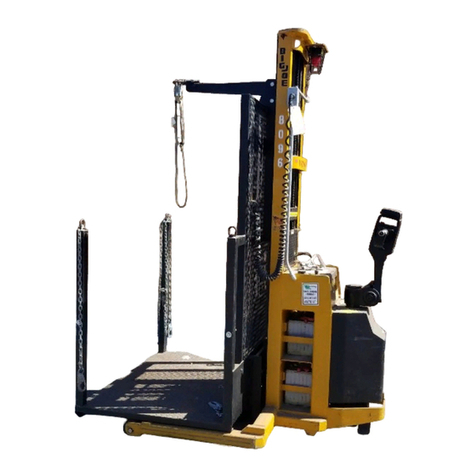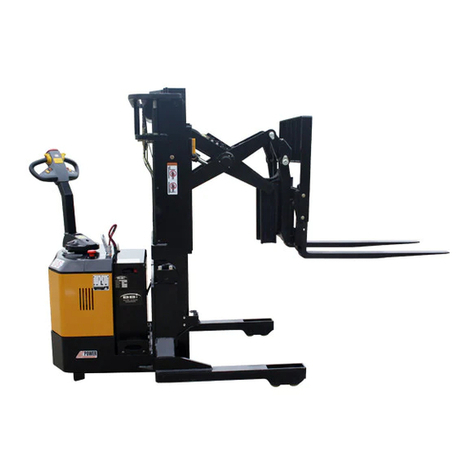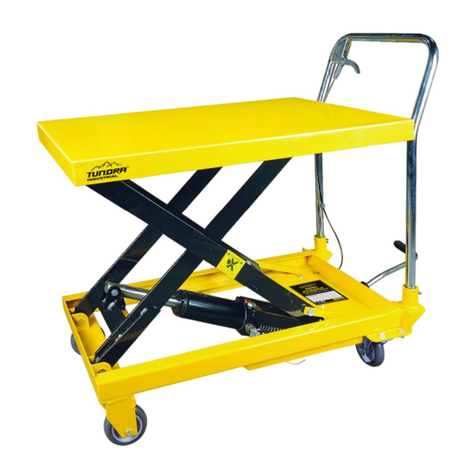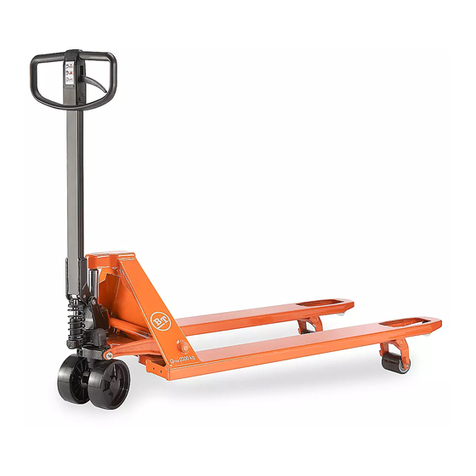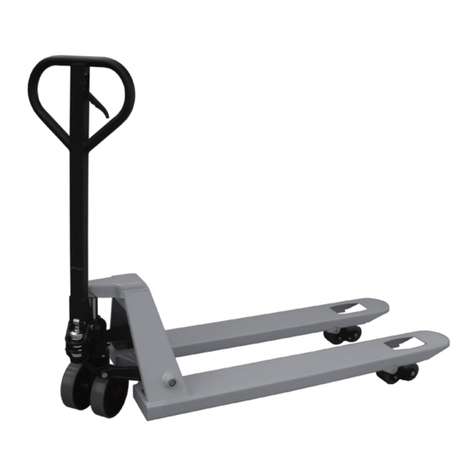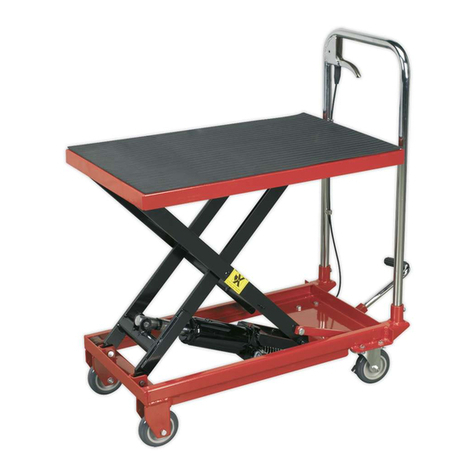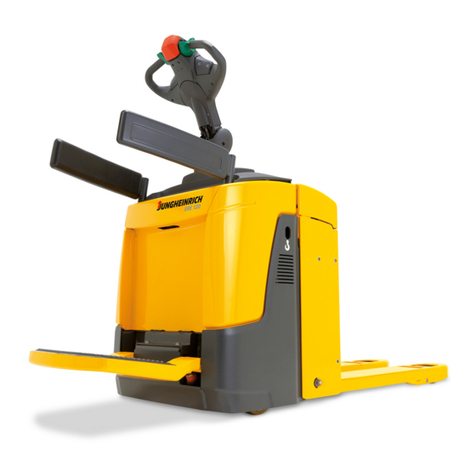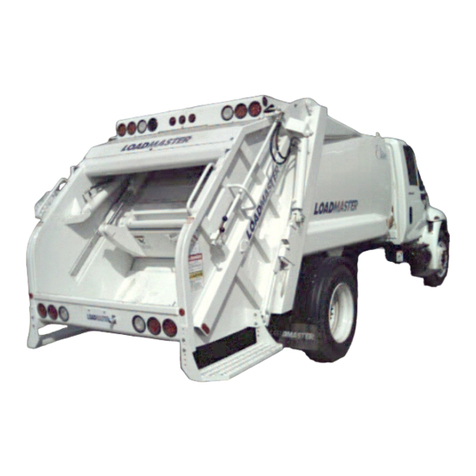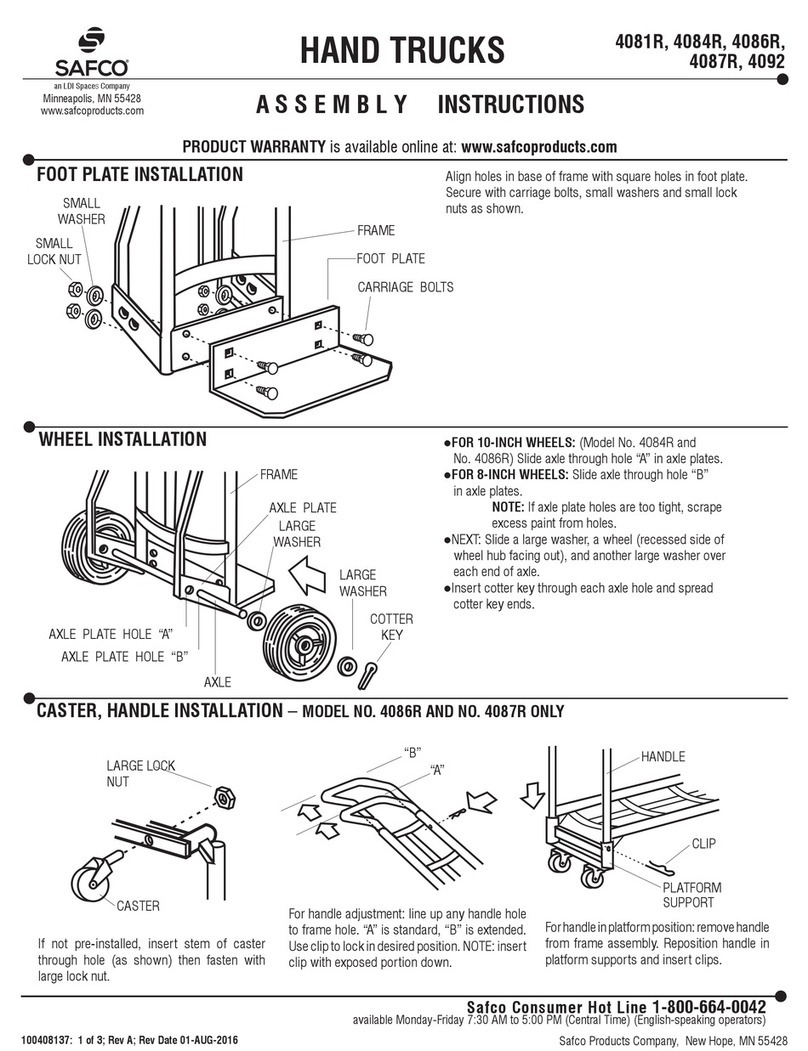Big Joe P33 User manual

OPERATOR’S MANUAL
Big Lift LLC
www.bigjoeforklifts.com Manual Part No. 901637
08/16/2018
POWER DRIVE
MANUAL LIFT
PALLET TRUCK
U.S. Patents Nos. 9,475,513; D754,415; D767,847 and D765,939


1
FOREWORD
As a lift truck operator, you are
responsible for a machine that is use-
ful, powerful, and can be hazardous if
not operated as described. Your Big
Lift LLC truck may weigh more than
some cars, depending on the model.
Observing and practicing the safety
warnings in this manual cannot be
overemphasized. Just knowing the
warnings, however, is no substitute for
common sense. Focusing on the task
at hand will, in almost all cases, pre-
vent accidents. Think of the truck as
your own. In this way you will learn its
capabilities and limitations.
This manual is intended to remain
with the truck at all times as a handy
reference guide to operation. Detailed
maintenance procedures are found in
the parts and service manual for the
specific truck model, and are to be
performed only by a qualified techni-
cian. For further information on
obtaining a complete parts and ser-
vice manual, see page 17 of this man-
ual.
The operator who knows his truck will
learn to spot problems as they
develop. This is accomplished by per-
forming the Daily Checks and report-
ing any problems to the designated
authority.
TABLE OF CONTENTS
SAFETY SYMBOLS..............................................................................................2
GENERAL DESCRIPTION....................................................................................2
NAME PLATE AND WARNING DECAL ...............................................................2
LOAD CAPACITY..................................................................................................4
BEFORE OPERATION..........................................................................................5
INSTRUMENTS AND CONTROLS.......................................................................7
OPERATION..........................................................................................................9
Forward & Reverse Travel......................................................................9
Steering....................................................................................................9
Lift and Lower..........................................................................................9
Parking.....................................................................................................9
Battery Charging...................................................................................10
Load Handling .......................................................................................10
Moving a Disabled Truck......................................................................10
NOTICE - OBTAINING A PARTS AND SERVICE MANUAL..............................17

2
SAFETY SYMBOLS
WARNING and CAUTION are both signal words intended to alert the viewer to
the existence and relative degree of a hazard. They are both preceded by a safety
alert symbol consisting of an exclamation mark enclosed by a triangle.
A Warning indicates a hazard which could result in injury or death if proper pre-
cautions are not taken.
A Caution indicates a reminder of routine safety practices.
A prohibition slash (circle with diagonal slash through it) indicates a procedure or
action that should not be performed under any circumstances, as both personal
injury and/or damage to equipment will result.
GENERAL DESCRIPTION
Big Lift LLC Pallet trucks lift and trans-
port loads on rigid forks.
Controls for steering, braking, for-
ward and reverse travel, horn, lift,
lower and speed control are all
located on the control handle.
Trucks in this series may vary in load
capacity, battery arrangement, and
instrumentation, depending on model
and options.
NAME PLATE AND WARNING DECAL
Name plate and warning decal loca-
tions may vary between models, but
they are always near the steering arm
within sight of the operator.
If the name plate or warning decal is
lost or damaged they should be
replaced immediately. Have your
supervisor or the designated author-
ity contact Big Lift LLC Authorized
Dealer for replacement.
The name plate shows the model
number, serial number, and truck
type. Battery type, with voltage and
minimum weight, is shown along with
information on the load capacity and
load center.
The warning decal contains warnings
which also appear, with illustrations, in
the Operation section of this manual.

3
Name Plate Location - Typical
This truck is equipped with a battery. Read and heed the following warning plus
any other warnings located near or on the battery. An example is shown here:
WARNING:
R7166

4
LOAD CAPACITY
Do not overload truck. Check name
plate for load weight capacity and load
center information.
The load capacity depends on the
load center. The load maximum
capacity listed on the capacity plate
assumes a uniform load whose center
is at 1/2 the length of the fork and cen-
tered between the forks. The maxi-
mum load capacity is reduced when
the load center exceeds 1/2 the length
of the forks or is not centered between
the forks. The fork length and wheel-
base must be adequate for the skid or
bin to be handled.
Note that a truck undergoing speed
changes is less stable than a standing
truck. If you are not sure that the truck
can lift a certain load, consult your
supervisor or the designated authority.
Load Center
R7167

5
BEFORE OPERATION
The table on page 6 covers important
inspection points on trucks which
should be checked prior to operation.
Depending on use, some trucks may
require additional checks.
The illustration below shows a sample
formatforanOperatorChecklist,which
canbemodifiedasnecessarytofityour
operation.
Periodic maintenance of this
truckbyaQUALIFIEDSERVICE
TECHNICIAN is required.
AQUALIFIEDSERVICETECH-
NICIAN should check the truck
monthly for proper lubrication,
proper fluid levels, brake main-
tenance, motor maintenance
and other areas specified in the
parts and service manual main-
tenance section.
If the truck is found to be unsafe
and in need of repair, or contrib-
utes to an unsafe condition,
report it immediately to the des-
ignatedauthority.Donotoperate
it until it has been restored to a
safe operating condition. Do not
make any unauthorized repairs
or adjustments. All service must
be performed by a qualified ser-
vice technician.
Sample of Operator Check List
WARNING:
WARNING:
WARNING:
R6235
Electric Truck
Daily Operator Check-Off List
Date
Big Joe ManufacturingCompany
Operator
Truck No. Model No.
Dept.
Check
Tires
Load Wheels
Horn
Lift Lower Control
Need MaintenanceO.K. ( )
Shift
Hour Meter
Reading Drive Hoist
Attachment Operation
Forward & Reverse Controls
Steering
Electrical Brakes
Hydraulic Leaks, Cylinders,
Valves, Hoses, Etc.

6
Operator Checks
ITEM PROCEDURE
Transmission and hydraulic
systems Check for signs of fluid leakage.
Forks Check for cracks and damage.
Guards and load backrest Check that safety guards are properly secured
and not damaged.
Safety signs Check that warning labels, nameplate, etc.,
are in good condition and legible.
Horn Check that the horn sounds when operated.
Steering Check for binding or looseness in steering
arm when steering.
Travel controls Check that speed controls on control handle
operate in all speed ranges in forward and
reverse and that belly button switch functions.
Wheels Check drive wheel for cracks or damage.
Move truck to check load wheels for freedom
of rotation.
Manual lift controls Check operation of manual lift and lower to
their maximum positions.
Brakes Check that brakes actuate when steering arm
is raised to upright position and when the bat-
tery disconnect is pulled out.
Deadman/Parking brake Check that steering arm raises to upright posi-
tion when released and brake applies.
Battery disconnect Check that battery can be disconnected and
reconnected. Check for connector damage.

7
INSTRUMENTS AND CONTROLS
The steering arm and control handle
provide controls for steering, forward
and reverse speed control, braking,
and raising and lowering the forks.
Control handles on all models have a
“belly-button” reversing switch which
reverses the direction of the truck
upon contact with the operator.
Detailed operating instructions are in
the Operation section of this manual.
A battery disconnect is mounted near
the steering arm. Pulling the discon-
nect removes all power from truck cir-
cuits in the event of an emergency.
Control Handle
1 Power Button
2 Optional Key Switch
3 Belly Button Switch
4 Reverse Button
5 Forward Button
6 Battery Indicator
7 Horn Button
R7160

8
POWER BUTTON
The power button (1) is used to switch
control current on and off.
OPTIONAL KEY SWITCH
The optional key switch (2) has two
positions, ON and OFF. Removing the
key prevents use by unautorized per-
sonal
BELLY-BUTTON BUTTON
The belly-button button (3) minimizes
the possibility of the driver being
pinned by the steering arm. If the
switch presses against the operator
while the lift truck is being driven
toward the operator, the switch
changes the direction of the lift truck.
FORWARD AND REVERSE BUT-
TONS
The forward button (5) and the
reverse button (4) provide fingertip
control for driving the truck.
BATTERY INDICATOR
When the key switch is turned on the
battery charge indicator (6) displays
the battery status. The colors of the
LED represent the following condi-
tions:
• The first LED lights when the battery
is properly charged. As the battery
charge decreases, additional LEDs
will light.
• When the second to the last LED
flashes, the battery is 70% dis-
charged.
• When the last two LEDs flash alter-
nately, the battery is 80% dis-
charged and needs to be
recharged.
The battery indicator has a memory
function, it can remember the battery
power after the power is shut down.
The next time the power is turned on,
it will show the last level of discharge.
Figure 1-1 Battery Indicator
HORN BUTTON
The horn button (7) located on the
front of the control head activates the
horn.

9
OPERATION
FORWARD & REVERSE TRAVEL
The forward and reverse controls are
located on the control handle.
Lower the control handle to a comfort-
able position to disengage the brake
and to energize the electric circuits.
Press the forward button (5) move for-
ward (with load in front).
To change direction or to stop the
truck, press the reverse button (4).
The truck will come to a stop and
then, unless the button is released,
accelerate in the opposite direction.
STEERING
Moving the control handle right or left
will turn the truck right or left. When
maneuvering around corners, make
square turns and be sure there is
adequate clearance.
STOPPING
Emergency Stop
Pull out the battery disconnect. All
electrical functions are cut out and the
brake is applied.
Automatic Braking
When the control handle is released, it
will automatically return to the vertical
position and the brake will apply.
Regenerative Braking
When the travel button (4 or 5) is
released, the truck automatically
brakes regeneratively. Once the truck
slows down the brake then fully
applies.
Inversion Braking
Press the opposite direction travel
button (4 or 5). The truck brake regen-
eratively until it starts to move in the
opposite direction.
LIFT AND LOWER.
Lift
Push down on control lever (2) and
move control handle (1) up and down
until the desired lifting height is
achieved. Reset lever (2) to the neu-
tral position.
Lower
Pull up on control lever (2) until the
desired lower height is achieved.
Reset lever (2) to the neutral position.
Figure 1-2 Lift Controls
PARKING
When parking the truck, do not
obstruct traffic lanes or aisles.
1. Park the truck in its designated
parking area.
2. Raise the control handle until ver-
tical to apply the parking brake.
3. Fully lower forks.
4. Turn power switch or optional
keyswitch to off position. Remove
key for added security.
5. Pull out battery disconnect.

10
BATTERY CHARGING
Refer to DOC 245 for battery safety
and maintenance.
NOTE: Battery charging instructions
are contained in the service
manual.
Load Handling
Handle only loads arranged for
stability and always use cau-
tion. Raise and lower the load
smoothly to prevent the load
from falling.
Always be sure the load and
load center are within the
capacity of the truck. If in doubt
check the nameplate.
1. Approach the load slowly.
2. Move the truck slowly into posi-
tion so that the forks are within
pallet or skid, and the load is cen-
tered over the forks and as far
back as possible.
3. Raise the forks to lift load.
4. Lead the truck by the control han-
dle with the load trailing except
when in confined areas. Ramps
should be traveled with operator
uphill of truck when empty, or
operator downhill of truck with
load on forks.
5. Always look in the direction of
travel. Move slowly and check
clearances when approaching
obstructions.
6. Do not make sudden starts and
stops. Operate truck smoothly
and gradually.
7. Travel slowly and squarely
around corners. Remember that
the trailing load wheels do not fol-
low the turn path of the drive
wheel. Instead they tend to cut
the corner.
8. Line up the truck with the unload-
ing area.
9. Stop the truck and check the load
alignment with surrounding
objects.
10. Be careful not to damage or
move adjacent loads and objects.
11. Lower the forks until the load is
resting on its own.
12. Move the truck back until the
forks are clear of the pallet.
Moving a Disabled Truck
Do not attempt to move a disabled
truck; notify your supervisor or proper
authority.
WARNING:
WARNING:

11
The following operating instructions appear on the truck warning decal, which is
located near the steering arm.
Do not operate this truck unless you
have been trained and authorized to do
so, and have read and understand all
warnings and instructions contained in
this operator’s manual and on this truck.
R7168
Do not operate this truck until
you have checked its condition.
Give special attention to
wheels, horn, battery, controller,
lift systems, brakes, steering
mechanism, guards and safety
devices. If you have any ques-
tions, notify your supervisor or
proper authority.
R7169

12
R7170
Operate truck only from walking
position.
R7171
Wear foot protection and
keep feet clear of truck.

13
R7172
Do not carry passengers.
R7173
Observe applicable traffic regulations. Yield right-of-
way to pedestrians. Slow down and sound horn at
cross aisles and wherever vision is obstructed.

14
R7174
Start, stop, travel, steer and brake smoothly. Slow down for turns and on
uneven or slippery surfaces that could cause truck to slide or overturn. Use
special care when traveling without load as the risk of overturn may be
greater.
R7175
Always look in direction of travel. Keep a
clear view, and when load interferes with
visibility, travel with load or lifting mecha-
nism trailing (except when climbing
ramps.

15
R7176
Use special care when operating on ramps; travel slowly, and do not angle
or turn. Travel with lifting mechanism downhill.
R7177
Do not handle loads which are higher
than load backrest or load backrest
extension unless load is secured so that
no part of it could fall backward.

16
R7178
Keep hands out of lifting mechanism.
R7179
When leaving truck neutralize travel con-
trol. Fully lower lifting mechanism and
set brake. When leaving truck unat-
tended also shut off power.

17
NOTICE - OBTAINING A PARTS AND SERVICE MANUAL
A complete parts and service manual covering this truck is available from Big Lift
LLC. Visit www.bigjoesupport.com to download a .pdf manual.

Big Lift LLC
Table of contents
Other Big Joe Truck manuals
Popular Truck manuals by other brands

Noblelift
Noblelift PTE15/20Q-B instruction manual
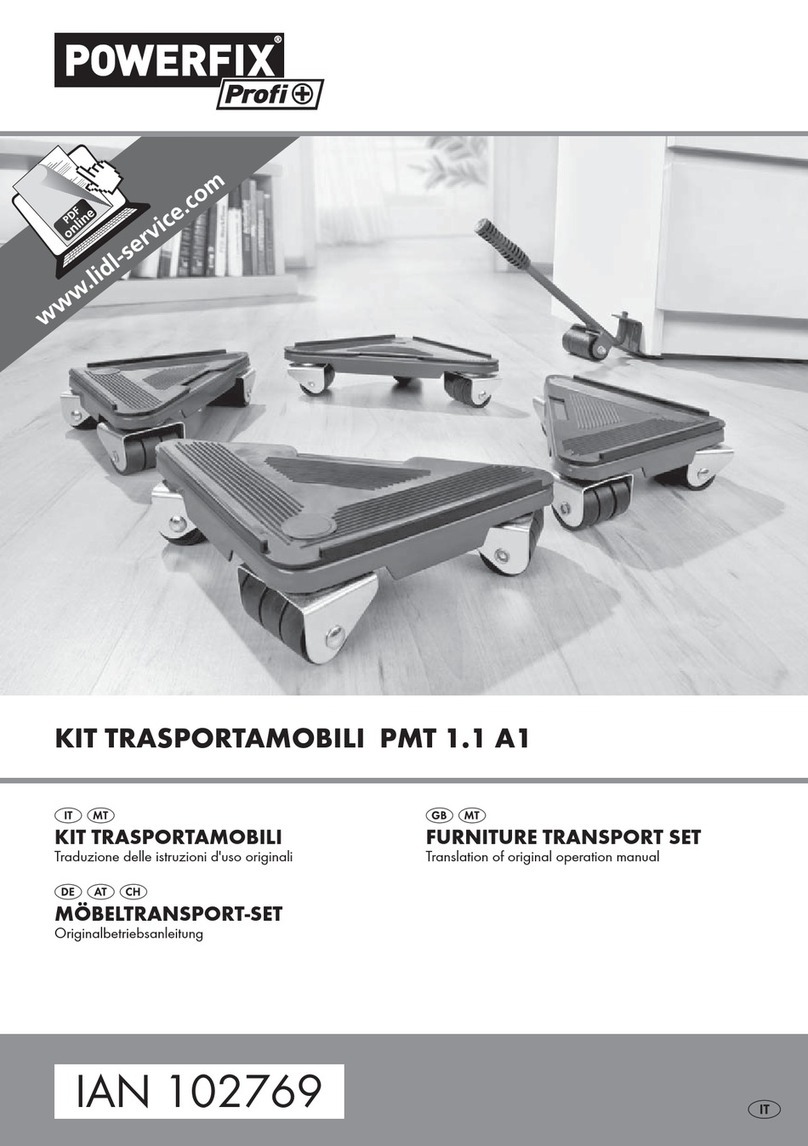
Powerfix
Powerfix PMT 1.1 A1 translation of original operation manual
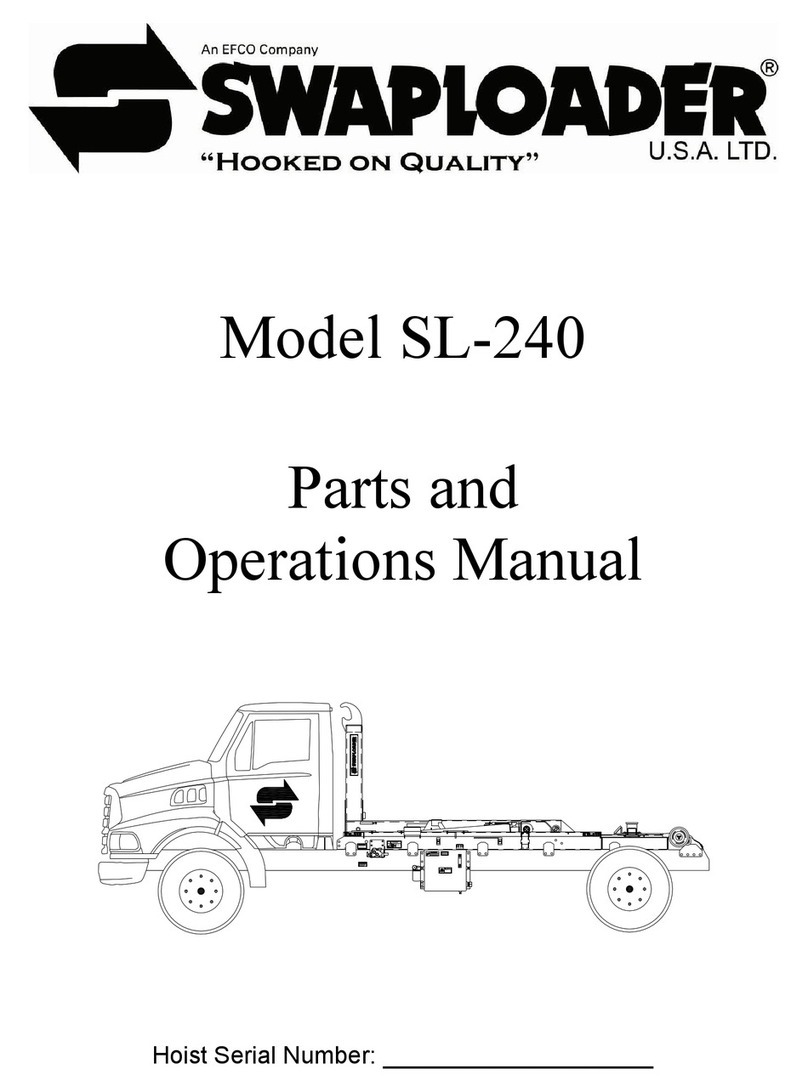
swaploader
swaploader SL-240 Parts and operation manual

Noblelift
Noblelift PS E12B Service maintenance manual

Doosan
Doosan D20G Specifications Systems Operation Testing & Adjusting
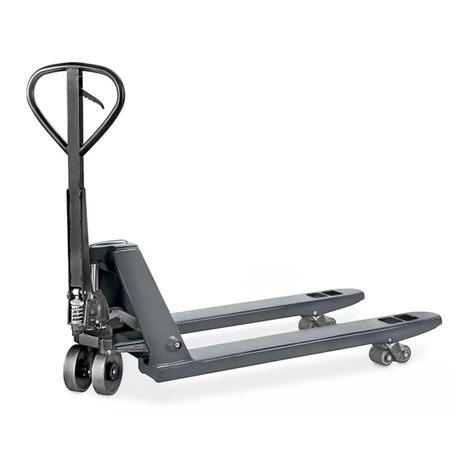
U-Line
U-Line H-5484 quick start guide
